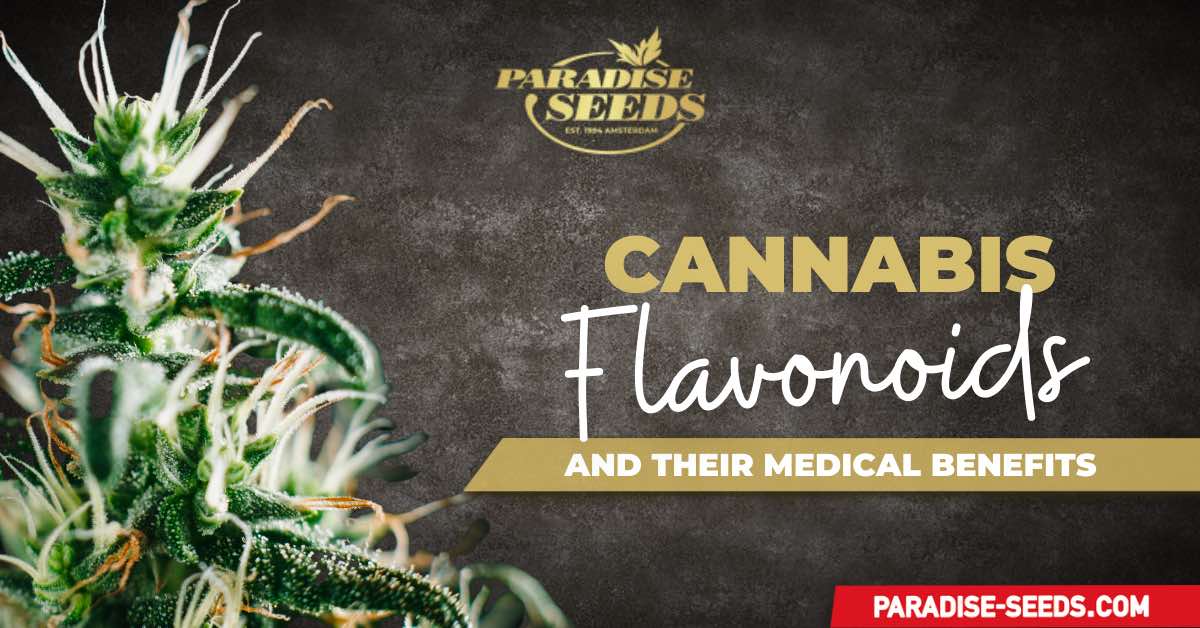Guest blogger Dr Viola Brugnatelli is the scientific director of Cannabiscienza, a lecturer at the University of Padua (Italy) and the Italian Ambassador for ICAM (International Association for Medical Cannabis).In her latest blog, she takes a closer look at cannabis flavonoids and how they can contribute to general health.
Cannabis, like many other plants, contains good quantities of flavonoids; Flavonoids are secondary metabolites produced by plants to play a protective role against ultraviolet irradiation and pathogens. The production and quantity of flavonoids depends on the type of plant and other external conditions such as nature of the soil, temperature and light. (1)
Scientific research has identified numerous beneficial effects that flavonoids can have on human health. Flavonoids can modulate the effects of cannabinoids and add medical benefits of their own.
Which flavonoids are produced by cannabis?
To date, over 20 flavonoids have been identified in cannabis. These compounds are mainly concentrated in flowers, leaves and stems. They represent about 2.5% of the dry weight of flowers and leaves, while they are almost non- existent in seeds and roots. (2,3) The flavonoids present in Cannabis, in addition to contributing to its pigmentation and smell, have beneficial effects, many of which are shared with cannabinoids and terpenes, as part of the “entourage” effect of the cannabis plant complex. (4)
The main flavonoids found in Cannabis are: quercetin, campferol, vitexin, apigenin, luteolin and Cannflavins. (5)
1) Quercetin is present in numerous plants, such as oak, is a compound with a strong antioxidant activity. (6) Quercetin, like other flavonoids, is able to slow the proliferation of many types of cancer cells (7) and also exerts a good anti-inflammatory activity, by inhibiting the formation of prostaglandins,. (8)
2) Kaempferol is a flavonoid with antiviral, antioxidant and anticarcinogenic properties and it seems that, if taken regularly as part of a person’s diet, it can prevent the development of some coronary heart diseases. (9); (10) Kaempferol is also a good natural antidepressant and it has been hypothesized that, in performing this action, it acts synergistically with cannabinoids. (11)
3)Vitexin is an active component of many traditional Chinese medicines. Various studies have shown that this phytocompound is capable of exerting numerous beneficial activities for health, such as anti-oxidant, anti-cancer, anti-inflammatory, anti- hyperalgesic and neuroprotective effects. (12) Furthermore, vitexin also has a promising antiasthmatic activity. (13)
4) Apigenin is a flavonoid present in high concentrations in many plants – such as chamomile for example – and has very interesting properties for humans, as it can produce antioxidant, anti- inflammatory and anxiolytic effects. In addition, apigenin, like other flavonoids, can inhibit the growth of some cancer cells. In fact, this phyto-compound is able to bind to hormone receptors, such as the oestrogen receptor, preventing the accumulation of hormones and thus slowing the proliferation of breast cancer cells. (14)
A biochemical transformation through the flavonoid enzyme 3 ′ hydroxylase (F3′H) oxidizes apigenin to form luteolin (5) another flavonoid present in the flowers and leaves of Cannabis plants (as well as in broccoli, chamomile or parsley), capable of modulating the activity of some enzymes involved in tumor pathologies. Luteolin is presumably the biochemical precursor of Cannflavins.
Flavonoids Exclusive to Cannabis
Unlike the previous examples, cannflavins A, B and C are flavonoids produced exclusively by cannabis plants. Cannflavins were first isolated from the cannabis plant in 1985 by a team of London researchers. (15)
The most studied Cannflavins are A and B, which have shown a powerful anti-inflammatory action – 30 times more powerful than aspirin – managing to act on some enzymes of the inflammatory cascade such as COX, but more specifically on 5-lipoxygenase and prostaglandin E2 synthase leading to a decrease in the production of prostaglandin E2 (PGE2), a pro- inflammatory molecule present in the pathological states of many autoimmune diseases.
This anti-inflammatory activity was initially assigned to the tetrahydrocannabinol (THC) molecule, but later it was found that cannabinoid-free cannabis extracts exhibited a better PGE2 inhibiting action than THC, underlining the potential of these non- cannabinoid molecules. (16)
The selectivity towards these targets by Cannflavins could evolve into a new strategy to fight inflammation with greater efficacy and less adverse effects than some traditional drugs. Furthermore, since some cannabinoids and terpenes also have anti-inflammatory activity, it is easy to imagine a synergy of action between these components.
The flavonoid component of cannabis shows promising actions that can improve human health. In addition to the activities highlighted in this article, many flavonoids are able to act at the level of cytochromes – enzymes capable of detoxifying the body and involved in the metabolism and elimination of many drugs and exogenous substances – by modulating absorption, distribution, metabolism and elimination of THC from the body.
Which part of the plant must be considered if one wants to benefit above all from the flavonoid component?
As already pointed out above, unlike cannabinoids present mainly in flowers, flavonoids have been found in flowers, leaves and stem, while campflavins, in some varieties are also produced by the plant during the formation of the bud. (18)
Concluding remarks
Often, when identifying substances with therapeutic activity in a plant, there is a tendency to no longer consider the plant in its entirety, but to focus only on isolating or extracting the identified substance. However, to benefit from the properties of Cannabis, given the presence of numerous compounds endowed with therapeutic activity such as cannabinoids, terpenes and flavonoids, it would be appropriate to consider the plant as a whole (phytocomplex). (17)
1) Vanhoenacker G, Rompaey P Van, De D, Sandra P. Chemotaxonomic Features Associated with Flavonoids of Cannabinoid-Free Cannabis ( Cannabis sativa subsp . sativa L .) in Relation to hops ( Humulus Lupulus L .). (December 2014):37–41
2) Andre CM, Hausman J, Guerriero G. Cannabis sativa : The Plant of the Thousand and One Molecules. 2016;7(February):1–17.
3) Choi YH, Hazekamp A, Peltenburg-looman AMG, Frédérich M, Erkelens C, Lefeber AWM, et al. NMR Assignments of the Major Cannabinoids and Cannabiflavonoids Isolated from Flowers of Cannabis sativa. 2004;354(October 2003):345–54
4) Do JMM, Russo EB, Russo EB. Cannabis and Cannabis Extracts : Greater Than the Sum of Their Parts ? 2016;9775(September)
5) Brenneisen R. Chemistry and Analysis of Phytocannabinoids and Other Cannabis Constituents. (7):17–49
6) Antioxidant Activities of Quercetin and Its Complexes for Medicinal Application Dong Xu, Meng-Jiao Hu, Yan-Qiu Wang, Yuan-Lu Cui. Molecules. 2019 Mar; 24(6): 1123
7) Flavonoids, Breast Cancer Chemopreventive and/ or Chemotherapeutic Agents. Magne Nde CB et al. Curr Med Chem. (2015)
8) Lichota A, Gwozdzinski L, Gwozdzinski K. Therapeutic potential of natural compounds in inflammation and chronic venous insufficiency. Eur J Med Chem. 2019 Aug 15;176:68-91
9) Kaempferol: A Key Emphasis to Its Anticancer Potential. Imran M et al. Molecules. (2019)
10) Kaempferol-induces vasorelaxation via endothelium-independent pathways in rat isolated pulmonary artery. Mahobiya A et al. Pharmacol Rep. (2018)
11) Inhibition of fatty acid amide hydrolase by kaempferol and related naturally occurring flavonoids. Br J Pharmacol. 2008 Sep;155(2):244-52.
12) A review on the pharmacological effects of vitexin and isovitexin. Fitoterapia. 2016 Dec;115:74-85.
13) Vitexin inhibits inflammation in murine ovalbumin-induced allergic asthma. Venturini CL et al. Biomed Pharmacother. (2018)
14) Scherbakov AM, Andreeva OE. Apigenin Inhibits Growth of Breast Cancer Cells: The Role of ERα and HER2/neu. Acta Naturae. 2015 Jul-Sep; 7(3): 133–139
15) Isolation from Cannabis sativa L. of cannflavin–a novel inhibitor of prostaglandin production. Barrett ML, Gordon D, Evans FJ. Biochem Pharmacol. 1985 Jun 1;34(11):2019-24
16) Oliver Werz, Julia Seegers , Anja Maria Schaible , Christina Weinigel , Dagmar Barz AK, Gianna
Allegrone, Federica Pollastro , Lorenzo Zampieri d , Gianpaolo Grassi e , Giovanni Appendino. Cannflavins from hemp sprouts, a novel cannabinoid-free hemp food product, target microsomal prostaglandin E 2 synthase-1 and 5- lipoxygenase. Elsevier [Internet]. Elsevier Ltd.; 2014;2(3):53–60.
17) Elsohly MA, Slade D. Chemical constituents of marijuana : The complex mixture of natural cannabinoids. 2005;78:539–48.
18) Flavonoid PA, Ross SA, Elsohly MA, Sultana GNN, Mehmedic Z, Hossain CF, et al. Flavonoid Glycosides and Cannabinoids from the Pollen of Cannabis sativa L . 2005;48(June 2004):45–8



